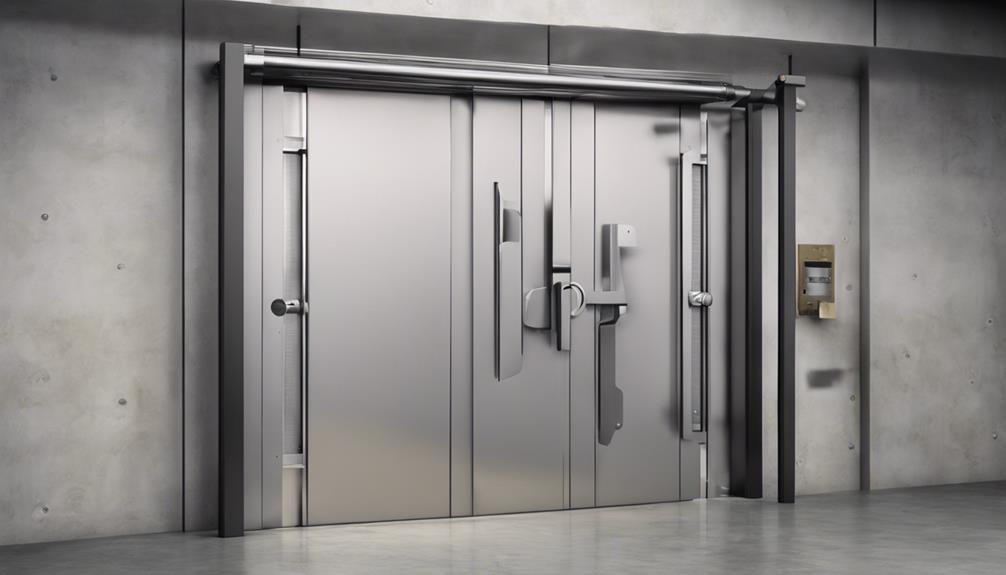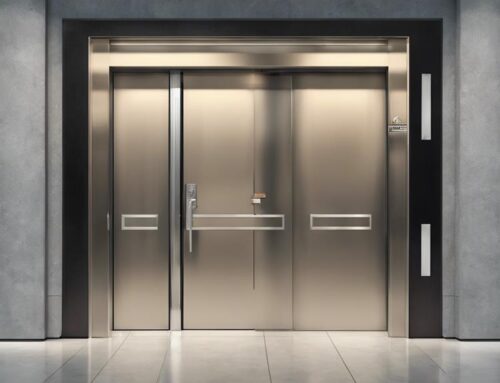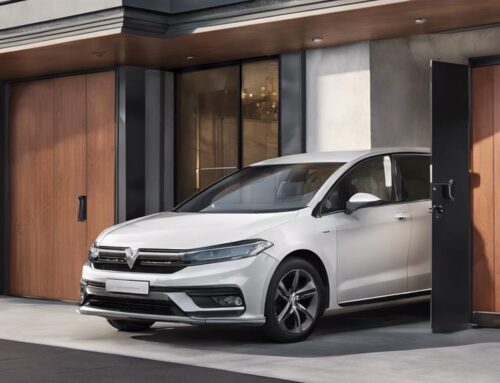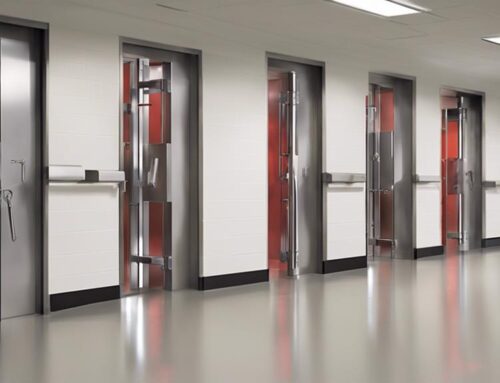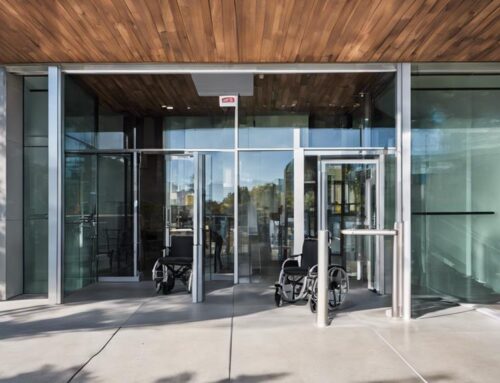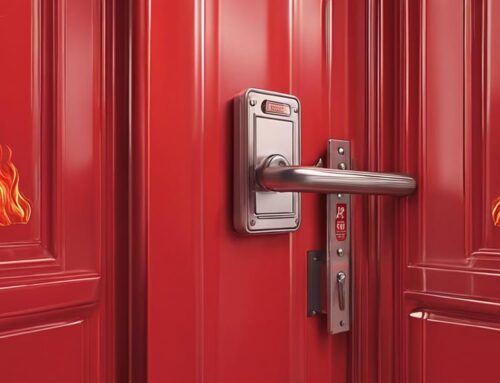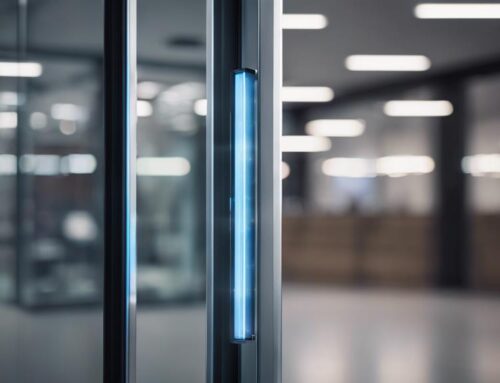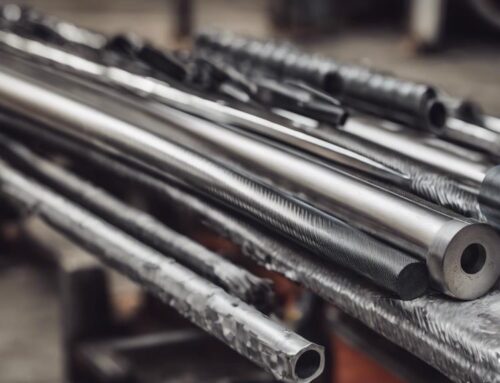When choosing a panic bar for your building's emergency exits, you'll find several options suited to different needs. Rim panic bars are surface-mounted, ideal for single doors. Mortise panic bars offer seamless installation with added security. Vertical rod and concealed panic bars provide secure and aesthetic solutions for double doors. Surface-mounted panic bars are easy to install, while crossbar and touch bar models facilitate quick exits. Alarmed panic bars enhance security with audible alerts, and electric panic bars integrate with access control systems. Exit only bars guarantee high-security egress. Explore further to match each type to your specific requirements.
Key Takeaways
- Rim Panic Bars: Surface-mounted, ideal for single doors, and easy to install with low maintenance.
- Mortise Panic Bars: Installed within the door cavity, offering robust security and a seamless look.
- Vertical Rod Panic Bars: Extends rods for added security, suitable for double doors without center posts.
- Touch Bar Panic Bars: Easy to operate, ADA compliant, and durable for long-lasting performance.
- Alarmed Panic Bars: Trigger loud alarms for unauthorized exits, enhancing security in commercial settings.
Rim Panic Bars
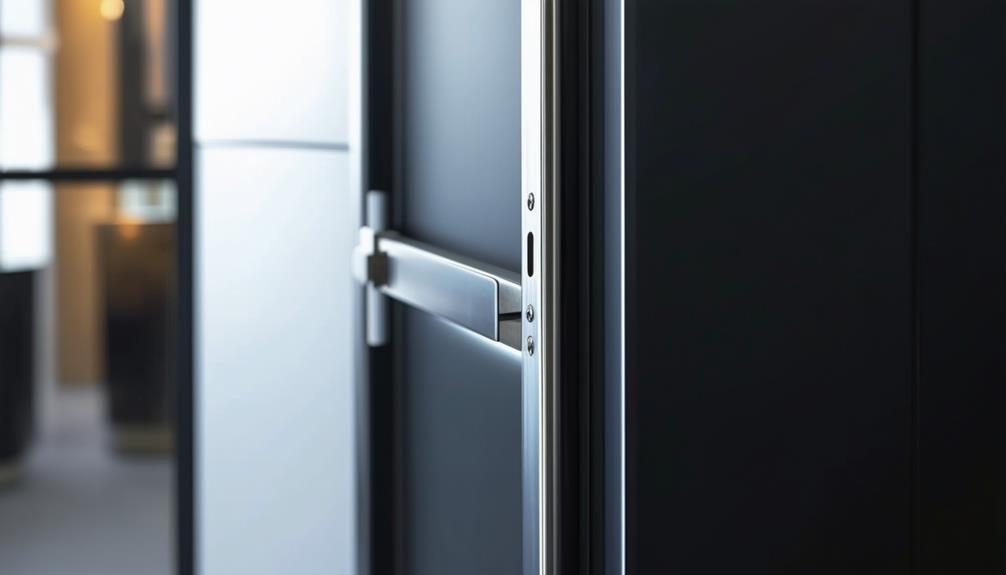
Rim panic bars, commonly called crash bars, are surface-mounted exit devices designed to guarantee quick and efficient egress by releasing a latch mechanism when you push the horizontal bar. Specifically crafted for single door applications, these panic bars assure straightforward installation, requiring minimal boring for key cylinders. This makes the installation process not only cost-effective but also less time-consuming.
When you install rim panic bars, you'll notice their latch bolt engages directly with the door frame. This feature guarantees a secure closure when the door is not in use, enhancing the overall security of the premises. One of the significant advantages of rim panic bars is their durability. They typically don't require adjustments after installation, which translates to low maintenance and long-lasting performance even under daily wear and tear.
It's essential to confirm these devices comply with building codes, especially in public buildings with high occupancy. Compliance guarantees that rim panic bars facilitate safe and swift exits during emergencies. By meeting these standards, you can be confident that you're providing a secure and reliable egress solution for any high-traffic environment.
Mortise Panic Bars
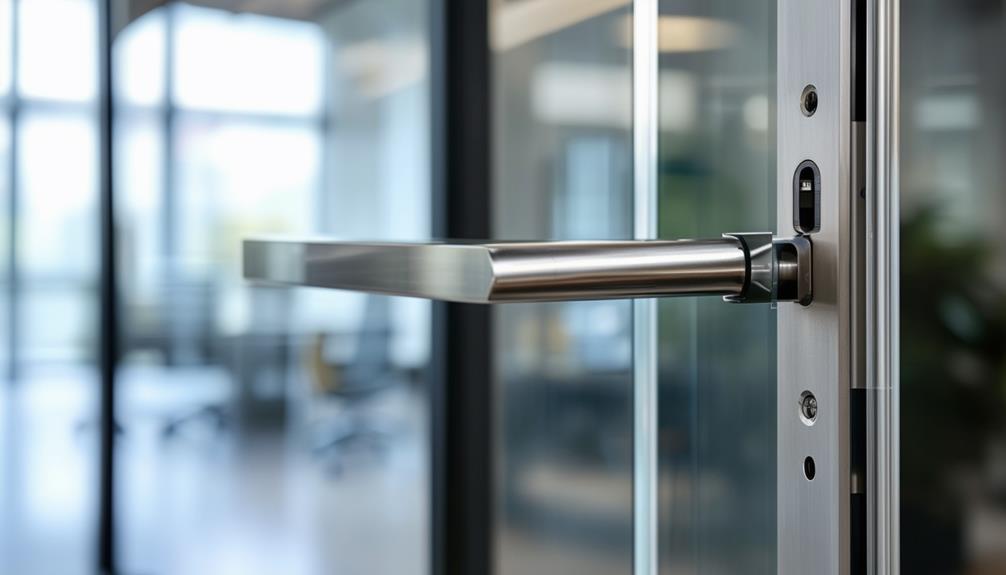
While rim panic bars offer a practical solution for single doors, mortise panic bars provide a more integrated and aesthetically pleasing alternative. Designed to be installed within the door cavity, mortise panic bars create a seamless appearance that is less intrusive compared to surface-mounted devices.
To install mortise panic bars, you'll need a specific mortise lock body, typically measuring 1" thick, 4" deep, and 6" high. Ensuring compatibility with your door's existing preparation is essential. This integrated design not only enhances the door's look but also offers robust security features, making them less prone to vandalism. Because of their sturdy construction, these panic bars are ideal for high-traffic areas and require minimal maintenance.
Mortise Panic Bars Overview
| Feature | Details |
|---|---|
| Installation | Within door cavity |
| Lock Body Dimensions | 1" thick, 4" deep, 6" high |
| Maintenance | Minimal, smooth release mechanism |
Mortise panic bars provide a smooth release mechanism, enhancing user experience during emergencies. They are versatile and can be paired with vertical rod mechanisms for increased security on double doors, particularly in fire-rated applications. This adaptability, combined with their minimal maintenance requirements, makes mortise panic bars a superior choice for those seeking both functionality and aesthetic appeal.
Vertical Rod Panic Bars
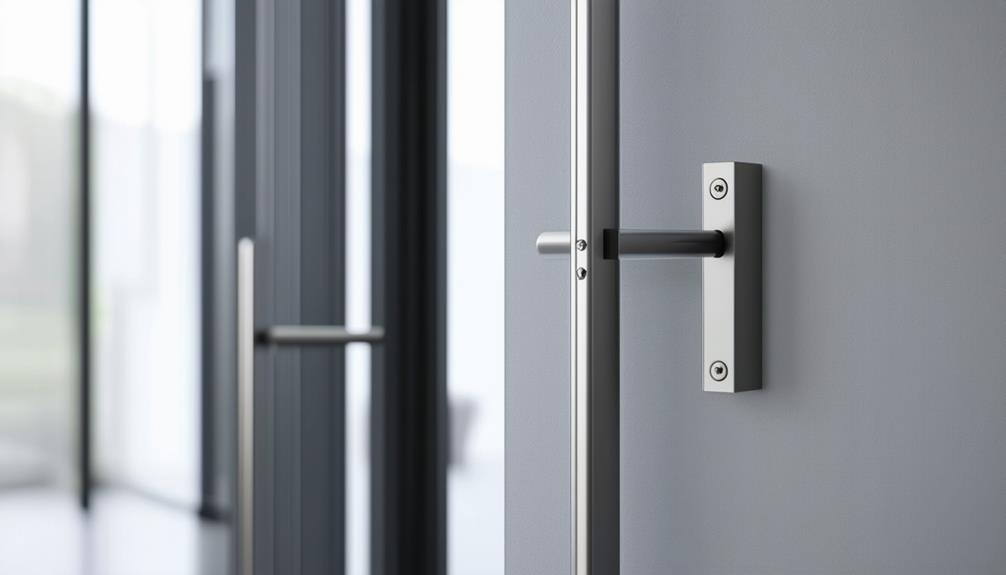
Vertical rod panic bars step up the security game by extending rods from the top and bottom of the door, securing it firmly at both ends when closed. These panic bars are especially effective for double doors without center posts, allowing for a seamless exit experience in high-traffic areas. When choosing vertical rod panic bars, you'll enhance your building's security and guarantee a smooth and reliable egress system. Additionally, they align well with fire code safety laws, ensuring your business remains compliant with essential regulations.
However, installation requires careful consideration. Ground heaving can necessitate frequent adjustments to maintain peak performance, so regular maintenance checks are critical. In surface-mounted designs, the exposed hardware can be vulnerable to damage from wheelchairs or hand carts. This means you need to be strategic about the placement to avoid compromising the integrity of the device.
Vertical rod panic bars come in both surface-mounted and concealed designs. Surface-mounted devices are easier to install but may not be suitable for areas where aesthetics are a priority. Concealed designs offer a cleaner look, making them ideal for modern architectural applications. By understanding these factors, you can make an informed decision that balances security, functionality, and visual appeal.
Concealed Panic Bars
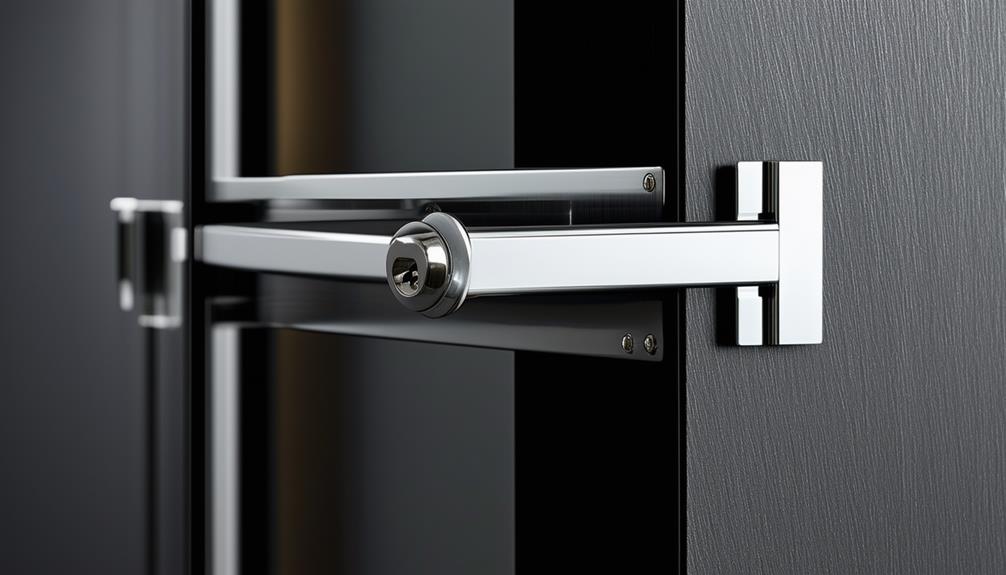
Concealed panic bars, with their hidden vertical rods, offer a sleek and clean aesthetic without compromising security. These bars integrate seamlessly into the door structure, presenting a refined appearance while guaranteeing safety. However, they require more complex installation compared to other types, including adherence to ADA compliance standards. If your doors aren't prepped for concealed rods, retrofitting can be labor-intensive and costly, often necessitating specialized knowledge and tools.
Concealed panic bars are ideal for aluminum framed storefronts, maintaining the streamlined look these settings demand. When considering these bars, compatibility with existing door models is essential. You might find it more cost-effective to replace the entire door rather than retrofit it for concealed panic bars, especially if the current setup isn't suited for this type of hardware.
Maintenance is another key consideration. Concealed vertical rod panic hardware may need frequent adjustments, particularly if the door shifts over time. Regular inspections can help guarantee that the mechanism remains functional and reliable. By understanding these aspects, you can make an informed decision about whether concealed panic bars are the right choice for your specific application, balancing aesthetics with practical security needs.
SurfaceMounted Panic Bars
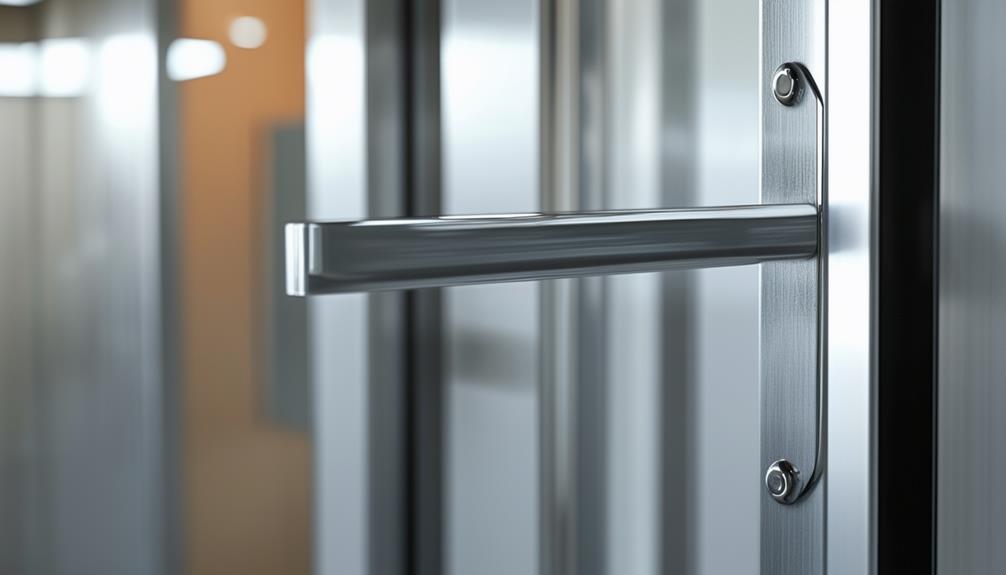
For those seeking a straightforward and versatile solution to secure their doors, surface-mounted panic bars, or rim exit devices, present an excellent option. These devices are installed directly on the door's surface, minimizing the need for extensive modifications and ensuring a hassle-free setup. If you're looking for an affordable way to enhance your business's safety, consider exit device installations that meet all safety regulations.
Surface-mounted panic bars feature a latch bolt that engages with the door frame, promoting quick and safe exits during emergencies while adhering to safety regulations. They are particularly well-suited for single exterior doors and primary double doors, offering reliable and low-maintenance operation.
Here are some key benefits of surface-mounted panic bars:
- Ease of Installation: Minimal modifications are needed, making it simpler to retrofit existing doors.
- Durability: Designed to endure daily use, ideal for high-traffic areas like commercial establishments.
- Compliance: Meets safety standards, ensuring that your facility is up to code.
- Versatility: Suitable for various door types, from single to double doors.
- Cost-Effectiveness: Provides a reliable solution without the need for frequent maintenance.
The design of surface-mounted panic bars allows them to withstand rigorous use, making them a preferred choice for many panic hardware applications. Their straightforward installation process and robust construction make them an excellent investment for enhancing door security and emergency preparedness.
Crossbar Panic Bars
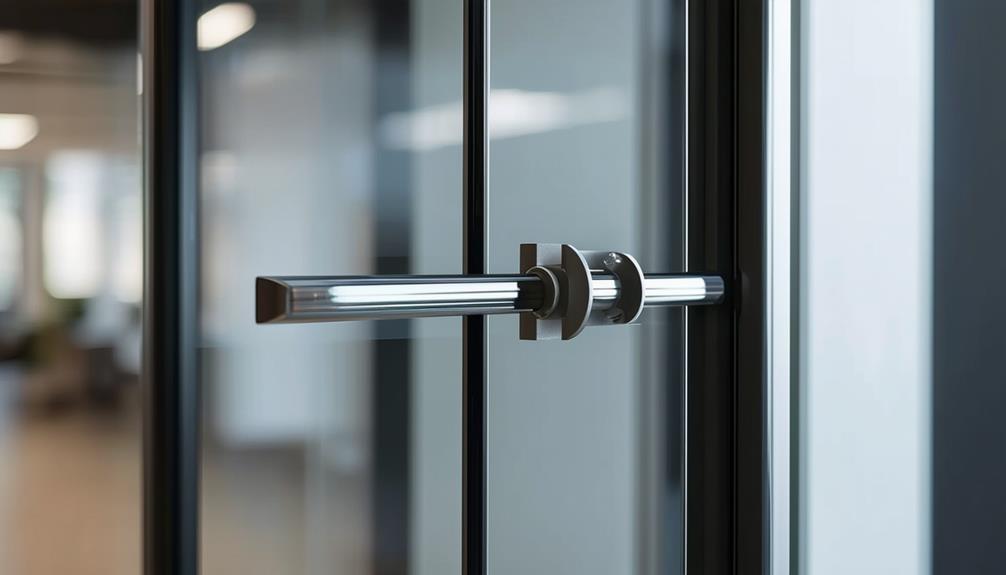
Crossbar panic bars are a reliable option when you need an efficient and intuitive emergency exit solution. Designed for quick and easy egress, these devices feature a horizontal bar that, when pushed, releases the latch mechanism instantly. The surface-mounted design makes crossbar panic bars versatile, suitable for single and double doors with minimal installation fuss. They comply with fire safety regulations, guaranteeing unblocked exits and reducing the risk of injury during emergencies.
In commercial settings, crossbar panic bars guarantee compliance with stringent safety regulations while enhancing the security of emergency exits. They come equipped with a durable latch bolt, ensuring robust performance even under frequent use. Some models offer electric functions, allowing seamless integration with access control systems for added convenience and security.
To maintain their effectiveness, regular maintenance and inspections are vital. Confirming proper functionality not only aligns with safety standards but also assures that the crossbar panic bars will perform flawlessly during emergencies. By staying committed to routine checks and upkeep, you can trust these devices to provide reliable and immediate egress when needed most.
Touch Bar Panic Bars
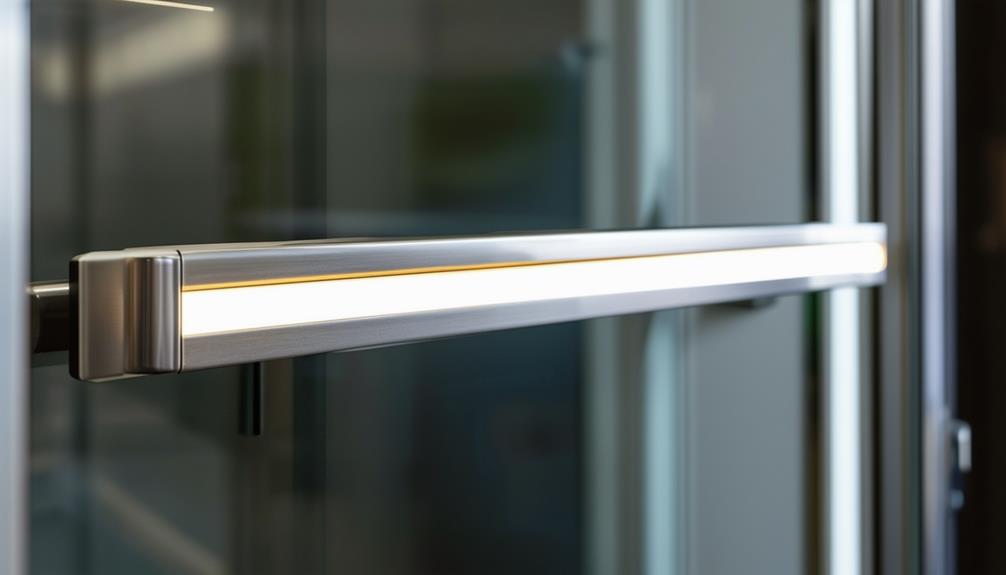
Touch bar panic bars, sometimes referred to as push pad panic bars, are a highly effective solution for ensuring swift and effortless egress during emergencies. By pressing a horizontal bar, users can quickly and easily open the door, facilitating rapid evacuation. These devices are specifically designed to meet rigorous accessibility standards, making them ideal for high-traffic areas where a speedy exit is essential. Additionally, touch bar panic bars can be integrated with existing security systems, enhancing overall building safety.
Touch bar panic bars offer several distinct advantages:
- Accessibility: Designed to be easily operated by all individuals, including those with disabilities.
- Reduced Force Requirement: Generally require less force to activate than traditional lever-operated devices, enhancing usability.
- Durable Construction: Often made from robust materials, ensuring long-lasting performance in commercial environments.
- Maintenance Needs: Regular maintenance, including lubrication and inspections, is vital for peak operation.
- Compliance: Typically adhere to industry standards for safety and accessibility, ensuring regulatory compliance.
Detex Panic Bars
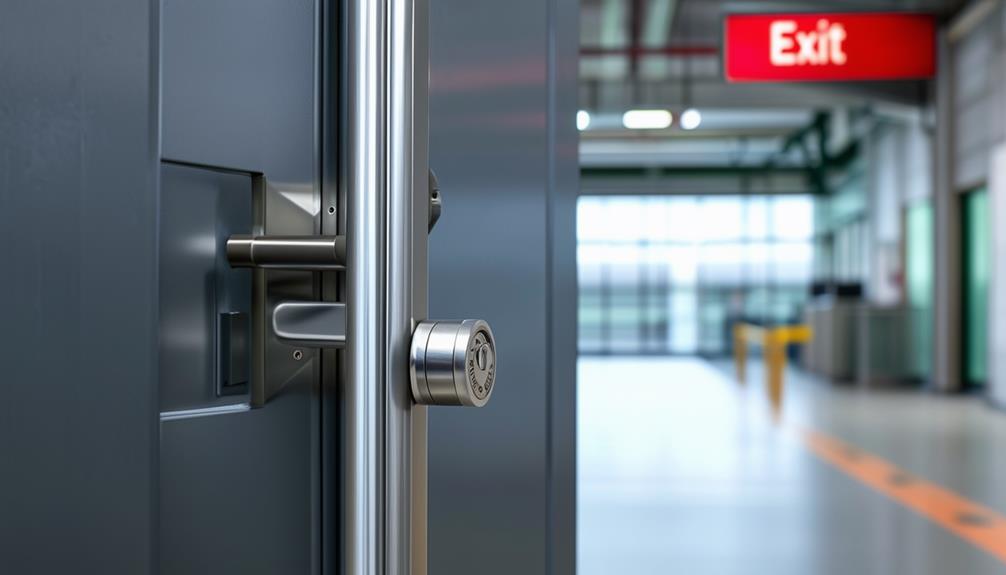
When it comes to guaranteeing swift and secure emergency egress, Detex panic bars stand out as a top choice for many facilities. These panic bars are engineered to provide quick and safe exits during emergencies, featuring robust alarm systems that deter unauthorized exits. This design guarantees that in the event of an emergency, occupants can evacuate swiftly while unauthorized access is minimized. Additionally, expert installation and repair services can further enhance the functionality and reliability of these panic bars.
Detex panic bars typically include a durable stainless steel deadlocking latch bolt. This critical component enhances security by preventing forced entry, making Detex panic bars not just a safety device but a security measure as well. These panic bars often accommodate various mortise cylinders, allowing you to customize the locking mechanism to meet specific security requirements.
Installation is straightforward, designed to minimize downtime and guarantee compliance with safety regulations. Detex panic bars are engineered for reliability, incorporating features that guarantee they function effectively even in high-traffic environments. Their design emphasizes durability and consistent performance, making them ideal for facilities that prioritize safety and security.
Exit Only Panic Bars
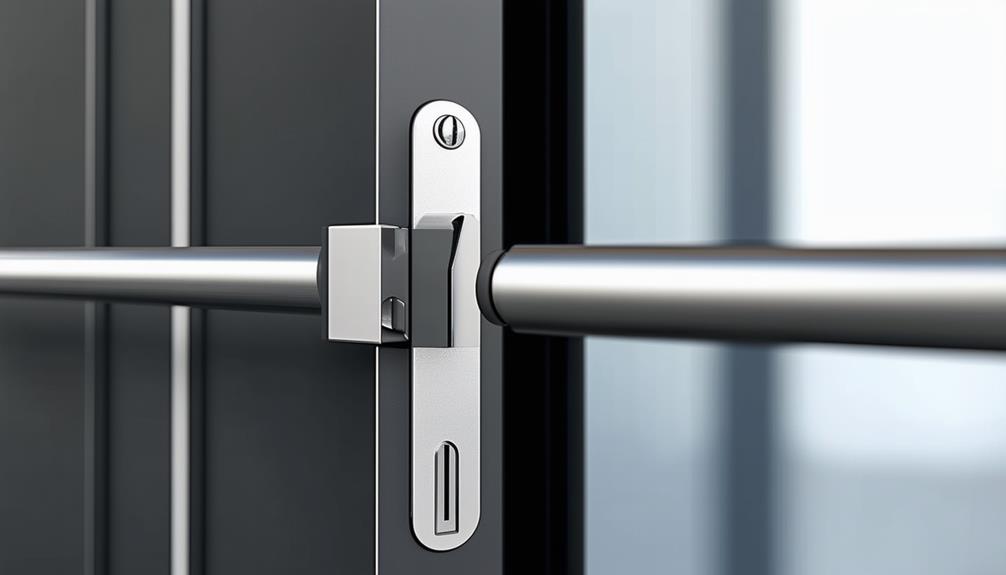
Exit only panic bars are vital for guaranteeing secure and efficient egress in emergency situations. These exit device panic bars are designed solely for egress, meaning they allow users to exit a building quickly without the ability to re-enter from the outside, enhancing security. Typically lacking exterior trim, they are often installed in high-security areas where unauthorized entry isn't permitted. For economical emergency exit solutions, Low Rate Locksmith offers tailored services available 24/7 across the nation.
Here's what you need to know about exit only panic bars:
- High-security installation: Ideal for places where preventing unauthorized entry is vital.
- ADA compliance: Guarantees accessibility for all users, including those with disabilities.
- Force-resistant mounting: Requires secure installation to withstand the pressure during emergencies.
- Regular inspections: Vital to maintain functionality and reliability.
- No exterior trim: Simplifies design, focusing on emergency egress without re-entry.
Adhering to these standards, exit only panic bars play a pivotal role in the overall safety strategy of any building. Installation needs to be meticulous, guaranteeing the bar can handle the stress of emergency situations. Regular inspections and maintenance are also key to their effectiveness, guaranteeing they function flawlessly when needed most. By understanding and implementing these devices, you're prioritizing both security and safety in your building's design.
Alarmed Panic Bars
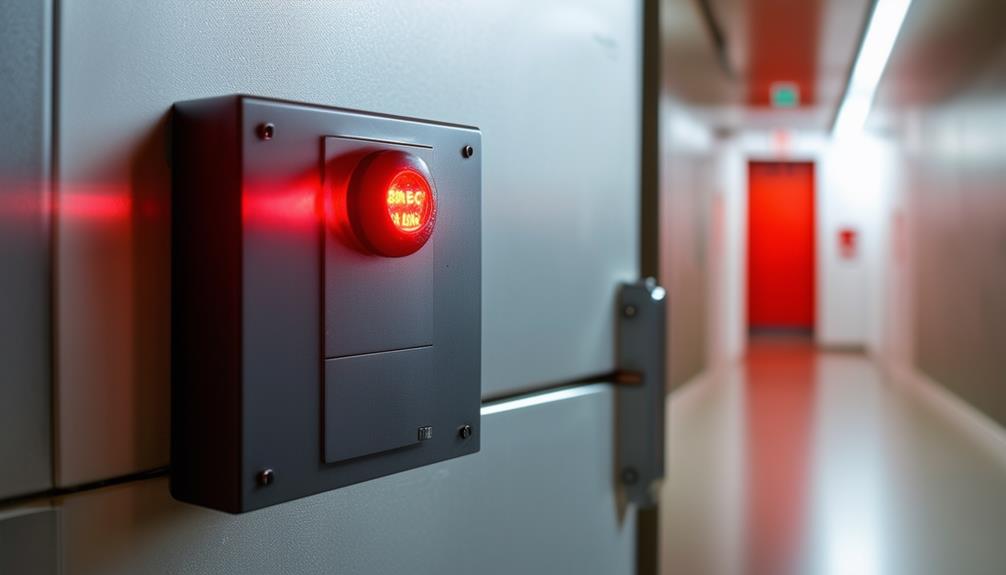
While exit only panic bars guarantee secure egress, alarmed panic bars add an extra layer of security by triggering an alarm during unauthorized exits. Alarmed panic bars are designed to produce a loud alarm—typically around 100 decibels—when someone attempts an unauthorized exit. This feature is particularly valuable in commercial settings like retail environments, where deterring theft and alerting management to potential security breaches is vital. Tailor your business's security with customizable panic bar solutions that meet specific safety and aesthetic requirements.
Incorporating alarmed panic bars into your security system guarantees that any unauthorized exit attempt is immediately noticeable to nearby personnel. The loud alarm acts as both a deterrent to potential thieves and a prompt for security or management to investigate the situation. These bars are constructed with durability in mind, often featuring deadlocking mechanisms to prevent tampering and unauthorized access, thereby enhancing overall security.
Additionally, it's essential that alarmed panic bars comply with building codes and safety regulations. These standards guarantee that the panic bars meet specific requirements for emergency exits, ensuring both security and safety. By integrating alarmed panic bars, you're not only enhancing security but also adhering to industry standards and regulations, guaranteeing a safer environment for everyone.
Low Rate Locksmith's Comprehensive Range of Panic Bar Options
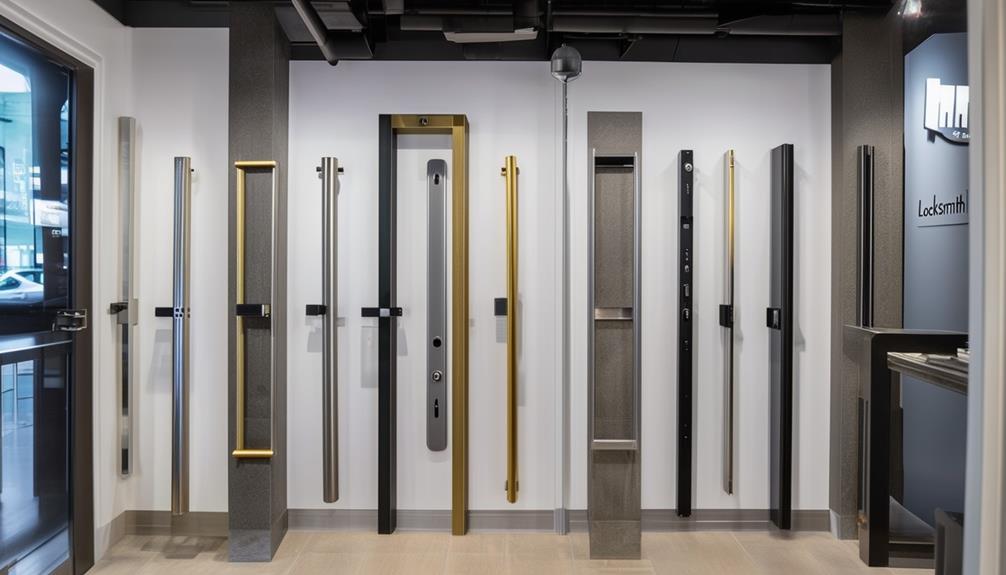
Taking security and functionality to the next level, Low Rate Locksmith offers a detailed range of panic bar options designed to meet diverse security needs and door types. Whether you're outfitting a small office or a large commercial facility, their selection of panic bars for commercial buildings guarantees you can find the perfect match for your requirements. Additionally, their offerings are comparable to those from leading brands like Von Duprin and Adams Rite, assuring top-tier quality and reliability.
- Rim Panic Bars: Ideal for single door applications, these bars are known for their easy installation and maintenance, making them a popular choice in various commercial settings.
- Surface Vertical Rod Panic Bars: These enhance security with rods that latch at both the top and bottom, making them perfect for double doors without center posts.
- Concealed Vertical Rod Panic Bars: For those seeking an aesthetically pleasing solution, these bars hide the rods within the door, suitable for storefronts and luxury venues.
- Electric Panic Bars: Integrating seamlessly with access control systems, these bars offer added security features and automated operation, ideal for high-traffic areas.
- Custom Solutions: Low Rate Locksmith also offers tailored solutions to address specific security needs and architectural requirements.
With this detailed range, you can trust Low Rate Locksmith to provide reliable, industry-standard panic bars that enhance safety and functionality in any commercial building.
Frequently Asked Questions
What Is the Difference Between Rim Panic and Mortise Panic?
You'll find that rim panic devices are surface-mounted, requiring less installation effort and maintenance. They latch to a strike plate on the frame. Mortise panic devices, however, fit within the door cavity, needing a precise mortise cut. They operate a mortise lock body, offering higher security and more locking options. Rim devices suit single doors or pairs with mullions, while mortise devices excel in high-security commercial entrances.
What Is the Difference Between a Panic Bar and a Crash Bar?
A panic bar is specifically designed for emergency exits, complying with safety codes and the ADA, ensuring quick egress without a key. A crash bar is a broader category that includes various exit devices, not all meeting regulatory standards. While both facilitate fast exits, panic bars prioritize emergency safety and compliance, whereas crash bars might lack these stringent features, focusing more on general functionality in less regulated settings.
Why Are Panic Bars so Expensive?
Did you know that over 80% of commercial buildings require panic bars by law? They're expensive because they must meet strict safety and building codes, using high-quality materials and rigorous testing. Installation complexity and the need for professional alignment add to the cost. Advanced features like electric retraction and alarm systems increase prices further. Durability, necessary for heavy use, and premium certifications also drive up costs considerably.
What Is the Difference Between a Panic Bar and a Push Plate?
You might wonder about the difference between a panic bar and a push plate. Panic bars guarantee rapid, secure egress during emergencies by releasing the door when pushed, meeting stringent safety regulations. Push plates, however, merely push the door open without releasing it, and they don't meet the same safety standards. Panic bars are essential for commercial buildings, whereas push plates are often used in less regulated environments.
Conclusion
In the world of emergency exits, choosing the right panic bar is like selecting the perfect key for a lock. Each type—be it Rim, Mortise, Vertical Rod, Concealed, Surface-Mounted, Detex, Exit Only, or Alarmed—serves a specific function and meets industry standards for safety and security. At Low Rate Locksmith, we offer an extensive range of panic bars to guarantee your building's exits are as secure and efficient as possible. Trust us to open your safety needs.

